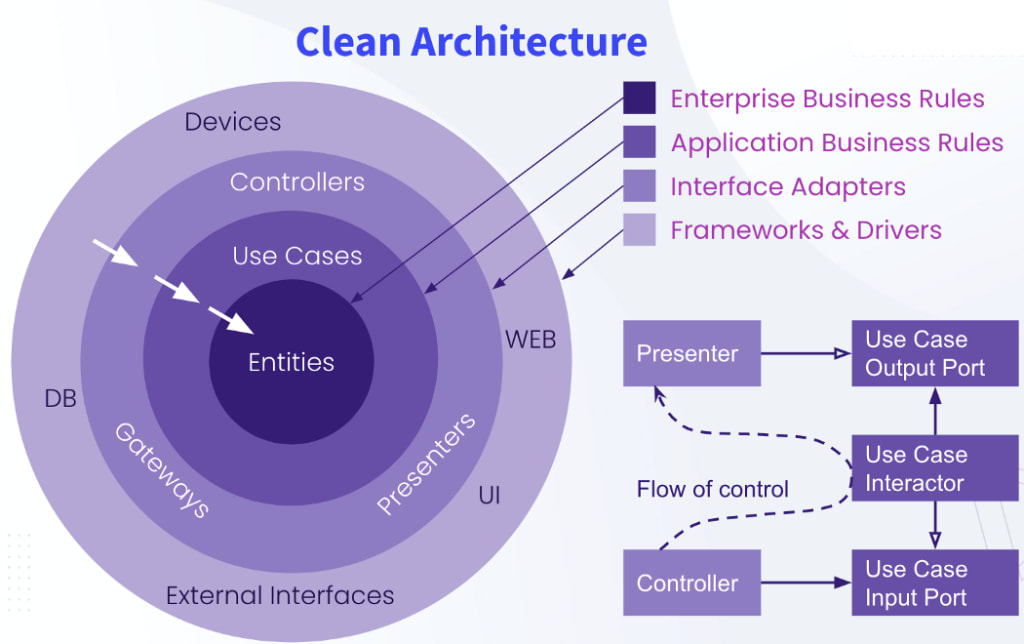Clean Architecture with Spring Boot
A Detailed Guide to Building Robust Java Applications

In the dynamic world of software development, the complexity of applications often grows exponentially with their functionality. To manage this complexity, a solid architectural foundation is essential. Clean Architecture, introduced by Robert C. Martin, provides such a foundation, and when combined with Spring Boot, a leading Java framework, it paves the way for scalable, maintainable, and efficient application development.
Deep Dive into Clean Architecture
Clean Architecture is structured around the following key principles:
- Independent of Frameworks: The architecture does not depend on specific software libraries, ensuring flexibility and ease of updates or changes.
- Testable: The business logic (or use cases) can be tested without UI, database, or any external elements, ensuring high-quality, reliable code.
- UI Agnostic: The system’s user interface can be changed without altering the underlying business rules.
- Database Independent: Business rules are not tied to a particular database, allowing various types of databases to be swapped in and out easily.
- External Agency Independence: The business logic is not dependent on external services, tools, or frameworks.
Layers in Clean Architecture
Clean Architecture is organized into concentric layers, each with distinct responsibilities:
- Entities: These are the business objects of your application. In a Spring Boot application, entities represent the domain model and are typically implemented as simple Java POJOs (Plain Old Java Objects).
- Use Cases: This layer contains application-specific business rules. It encapsulates and implements all of the use cases of the system.
- Interface Adapters: This layer converts data from the format most convenient for use cases and entities to the format most convenient for external agencies and vice versa. In Spring Boot, this typically involves controllers, view models, and data access objects (DAOs).
- Frameworks and Drivers: The outermost layer of the architecture consists of tools like database engines, web frameworks, and other external libraries or frameworks. Spring Boot, with its auto-configuration and dependency management, sits in this layer.
Implementing Clean Architecture in Spring Boot
To implement Clean Architecture in a Spring Boot application, follow these steps:
1. Domain Layer Implementation:
- Define entities that encapsulate enterprise-wide business rules.
- Implement repository interfaces to abstract data access, allowing for different data storage implementations.
2. Application Layer Implementation:
- Implement service classes that contain business logic. These services should use entities and interact with the database through repository interfaces.
- Create DTOs (Data Transfer Objects) to transfer data between different layers.
3. Adapter Layer Implementation:
- Implement controllers that handle HTTP requests and responses. Controllers should interact with services and convert DTOs to/from domain entities.
- If using a relational database, implement the repository interfaces using Spring Data JPA or a similar Spring Boot abstraction.
4. Infrastructure Layer Implementation:
- Configure Spring Boot starters for specific database technologies, web frameworks, security, etc.
- Utilize Spring Boot’s auto-configuration to set up your application’s infrastructure components, like databases, caching, messaging systems, etc.
5. Best Practices and Considerations
- Decouple Layers: Ensure that changes in one layer (like swapping out a database or changing a UI framework) have minimal impact on other layers.
- Testing: Leverage the separation of concerns to write unit tests for business logic without needing external resources, and integration tests for adapters and infrastructure components.
- Dependency Rule: Depend inward, not outward. Inner layers should define interfaces that outer layers implement, ensuring that business logic remains unaffected by external changes.
Conclusion
Integrating Clean Architecture with Spring Boot allows developers to build robust, scalable, and maintainable Java applications. By segregating different aspects of the application into clear, interchangeable layers, Clean Architecture ensures that the application remains resilient to changes in frameworks, databases, or user interfaces. Spring Boot complements this architecture by providing a flexible and powerful platform to implement and manage these layers effectively. The combination of Clean Architecture’s principles with Spring Boot’s capabilities offers a potent framework for building enterprise-grade applications.
Thank you for reading until the end.
About the Creator
HABBICHE Lotfi
Hi my name is Lotfi, i am a software engineer who love to write about mobile / web dev, AI and computer science stuffs.






Comments
There are no comments for this story
Be the first to respond and start the conversation.